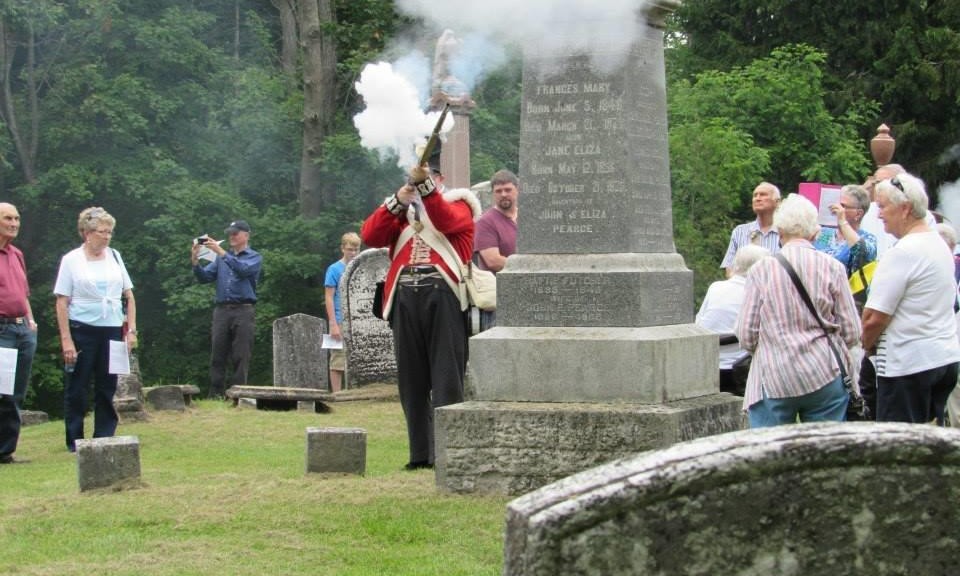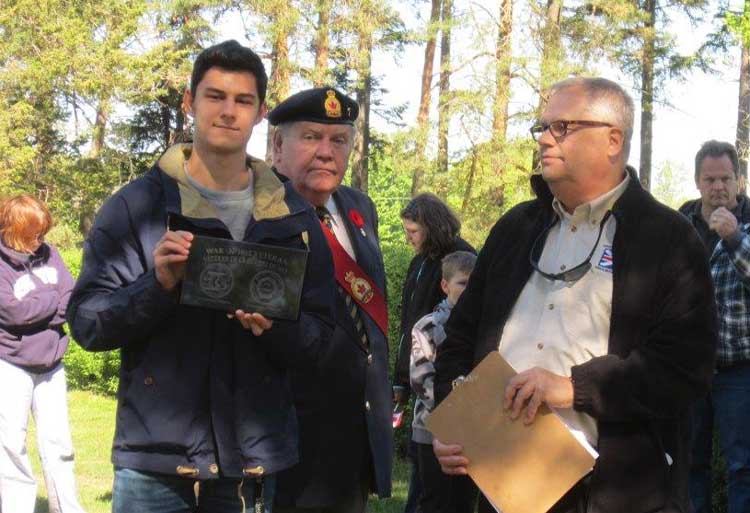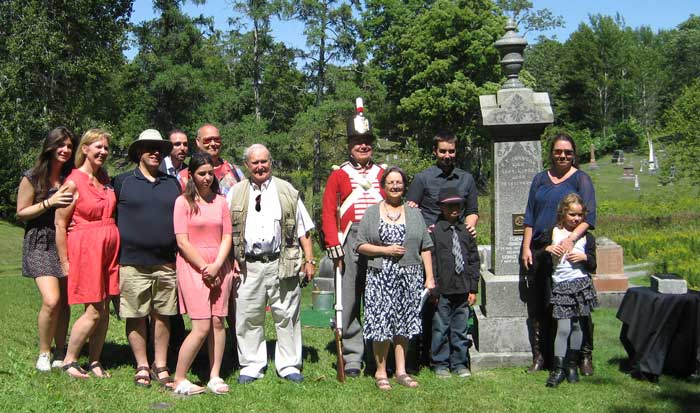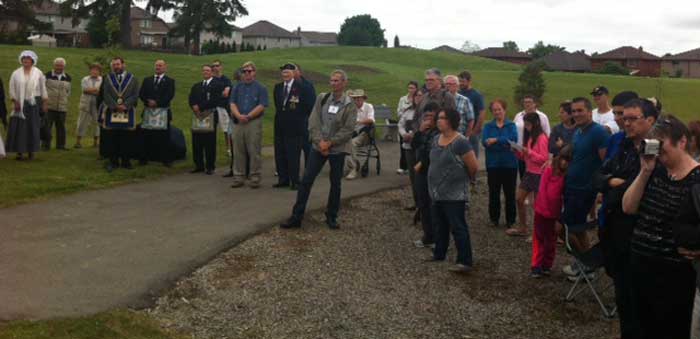John Pearce was born in 1777 in Rhode Island. He moved to Erie Pennsylvania sometime before 1800 and married Frances Patterson. In 1808, he and his brother-in-law Leslie Patterson made an trip to Upper Canada when they learned that tracts of land were opening for settlement. They found the Talbot Settlement on the shore of Lake Erie to be to their liking and Thomas Talbot gave them lots. They brought their families the next year. A worker for Colonel Talbot had already begun to grow crops on Pearce’s land prior to their arrival.
John Pearce
Benjamin Gilman Willson
Flank Company
1st Regiment Middlesex Militia
Benjamin Gilman Willson was born near Fort Erie in 1796, the first boy after two girls in a family that grew to 12 children. Benjamin G.’s father and grandfather had had roles in public affairs in Bertie Township. His father, Gilman, was a farmer, a land assessor and a captain in the Lincoln Militia; his Willson grandfather, Benjamin, was a farmer, and a justice of the peace.
In 1811, the Willsons took up a land grant farther west in a fledgling settlement called Port Talbot on Lake Erie. Their land would have been virgin forest so the winter would have been spent clearing land to build a house and planting crops in the spring. The War of 1812 to 1814 broke out shortly after the family arrived. At first it affected the Port Talbot settlement very little, though a defense was raised. On February 12, 1812, Benjamin G.’s father Gilman was commissioned Captain in the 1st Regiment Middlesex Militia. Thomas Talbot, the founder of the settlement, was commissioned Colonel and placed in charge of the Middlesex Militia and Supervisor for the District of London. Benjamin G. was on service in the militia from 1812 at which time he was about 16 years of age. He was a private during the war, serving to protect his community under Captain Leslie Patterson and Captain David Secord.
By 1813, the British had lost control of Lake Erie and the Thames River, and had been driven back from the area. Consequently, the whole area was left undefended except for the local militias. There were numerous raids on the Talbot settlement by groups of American marauders. One document in the Talbot Papers records the activity of Benjamin G. Willson during such a raid.
On May 20, 1814, Port Talbot got a half-hour notice of the approach of a raiding party from the north. Two groups of local militia started to convene from different points along Talbot Road. It is documented that Benjamin G. was with one group of seven men until his father, Captain Gilman Willson, took him away, perhaps to help him guard the mills that were essential to the settlement. Therefore, the first group decided to wait for reinforcements. The other group of seven men did not manage to meet them until it was too late. When the raiders arrived, the settlement was deserted, except for those on guard there. The guards were overpowered and taken prisoner. On reflection, the militia commander, Lieutenant-Colonel Mahlon Burwell, felt the first group could have challenged the raiders if Benjamin Gilman had been allowed to stay.
Another raid occurred on September 9, 1814 by an army under General McArthur and Andrew Westbrook numbering as many as seven hundred. The militia was fighting elsewhere. Port Talbot was completely destroyed. Mills, homes and barns were burned, animals killed or driven off, and the stored supplies ruined. The settlement never truly recovered.
The War of 1812 ended with the signing of the Treaty of Ghent on December 24, 1814 and life started to return to normal. For his service, Benjamin G. was granted 200 acres in the neighbouring township of Southwold. He put in a petition for Lot 25 Talbot Road East, North Side on the 18th of July 1817. On November 27, 1819 they received the patent for their property. The 1864 Tremaine Map shows a house on the east half of the property near the road. This is probably the location of the family home.
On May 21 1818, he married Elizabeth Kitchen. Very little is known about Elizabeth. According to the 1861 Census of Canada West, she was born August 31, 1797 in the United States. Family lore states that it was Pennsylvania, and that her parents were John Kitchen and ___ Miller. Family lore also says they were married in Dunwich Township by Mahlon Burwell. Other than those few hints to her life, there is nothing else that can be documented at this time.
Benjamin G. and Elizabeth’s children were:
1. M. Gilman Willson, born April 17, 1819, died December 23, 1902, a carpenter joiner in Fingal, later becoming a Methodist Minister and moving to Egremont Township and on to Bracebridge, Ontario.
2. John Kitchen Willson, born September 19, 1821 and died May 11, 1906, a harness maker and farmer who settled first at Morpeth, Howard Township, Kent County, and then Harwich Township in 1853.
3. Philo Willson, born September 20, 1823, died young.
4. Ann Willson born December 27, 1825 married George Burt, moved to Michigan.
5. Edward Samuel Willson, born March 17, 1828, died February 1, 1925, a saddler in Fingal, and later a farmer in Aldborough Township, Elgin County and Howard Township, Kent County.
6. Eliza Jane Willson, born August 23, 1830, married Hiram Bell, in Southwold October 11, 1852, living in Nebo, Kent County after marriage. Died February 19, 1911.
7. Sarah Willson, born November 12, 1833, married Nelson Welter September 13, 1859. They lived on Jabel Robinson farm, Southwold, went from there to near Glencoe where he died and was buried, (The Commemorative Biographical Record of 1904 says Sarah was married to William Welter and lived in Nebo, Kent County.) They had two sons and one daughter – Charles, William Isaac and Alice. Sarah Willson Welter and children went away to her brother who lived at ______.
8. William B. Willson, born November 8, 1835, died January 31, 1860, at 24 years of age, buried in Fingal Cemetery.
9. Charles Benjamin Willson, born July 1, 1838.
10. Elizabeth Williams/Willson grew up in the Willson household. Family lore says she was an adopted daughter. Her parents were George R. and Ann Williams. Elizabeth married Israel Morse and died in 1917 at 76 years of age.
In the 1820s, Benjamin G. and his brothers were granted more land. Two possible reasons for this could be because the family were supporters of Thomas Talbot, the founder of the settlement, or that as sons of Loyalists they were entitled to claim land. At this time the rich farm lands of Kent county were being settled. Along with others from Elgin County, Benjamin G. and two of his brothers, Crowell and Edward, became original patentees in Howard Township, being granted 100-acre lots clustered together along Middle Road. Benjamin was the first to qualify for his patent (1838), however, he sold that property and continued to live in Southwold Township.
As time went by, discontent arose in Upper Canada over how officials and politicians were using their influence to reward their own through land grants and positions. This discontent culminated in another conflict, the Rebellion of 1837/1838. On October 24, 1838 a militia was formed. Being Tory supporters, Benjamin G. and his oldest son M. Gilman signed up for active service that day in the St. Thomas Troop of Cavalry. Both were privates, and were additionally assigned to be “dispatch riders”. The pay rate for a private was 1 shilling 5 pence per day. There was a separate pay list for “Rations and Forage” of 3 shillings per day and a further pay list for “Horses and Horse Furniture” at 2 shillings and 6 pence per day. Those who were dispatch riders received an extra allowance. In February of 1838 privates were supplied with blankets valued at 10 shillings each. Benjamin G. does not appear on the pay lists after April 1839. A branch of the Willson family owns a sword that probably belonged to Benjamin G. Willson. Family lore says the owner of the sword fought in both the War of 1812 and the Rebellion of 1837. Benjamin G. was the only one to fight in both wars.
Once into his fifties, Benjamin Gilman was involved in Southwold affairs. He was made a constable in 1853. By the 1871 census he was listed as a bailiff of the Third Division Elgin County Court. One incident highlights this part of his life.
In January of 1859 with none of their offspring intending to farm the land, Benjamin G. and Elizabeth sold the old homestead and moved into the nearby town of Fingal.
In 1875, the Canadian Parliament voted to distribute the sum of $50,000 in $20 increments to all Canadian militia veterans of the War of 1812 who were still alive and residing in Canada. Surviving veterans were invited to apply. Benjamin G. at age 79, was listed as a recipient.
Finally, in 1875, Benjamin G. and Elizabeth moved to Kent County to spend their remaining days with family. In 1878 at 80 years of age, Elizabeth died at the Cedar Springs home of their son, John Kitchen. Benjamin G. died at the home of their son, Edward Samuel, in Troy in 1885, aged nearly 90 years. By then there were few Willsons left in Elgin County and many of Benjamin G. and Elizabeth’s siblings, children and grandchildren had died or gradually moved away from Kent County, as well. There is no recorded burial, but, according to family tradition, Benjamin G. and Elizabeth are both buried at Cedar Springs in Harwich Township, perhaps on John Kitchen Willson’s farm.
For more information on the Talbot Settlement on Lake Erie during the War of 1812, see the following Veterans elsewhere on this site and linked here:
- Gilman Willson
- George Crane
- Thomas Talbot
- Mahlon Burwell
- Stephen Backus
- Leslie Patterson
Family Link: Gilman Willson
Stephen Backus
Flank Company
1st Regiment Middlesex Militia
Stephen Backus was born in New York State on Dec. 25, 1786.
He moved to Pennsylvania with his family about 1800, and then moved to the Talbot Settlement on the north shore of Lake Erie in 1810 to join his sister Lydia (Backus) Patterson. There he married Anne Storey who had come to the Talbot Settlement the previous year. He died November 4, 1865 at 78 years of age.
Continue reading Stephen Backus
Flank Company
1st Regiment Middlesex Militia
Leslie Patterson
1st Regiment Middlesex Militia
In 1800, three siblings, Leslie Patterson, Mary Storey and Fanny Patterson moved from County Fermanagh, Ireland, to Harbour Creek, Pennsylvania, on Lake Erie. While there, Leslie Patterson married Lydia Backus from Vermont, and his sister Fanny married John Pearce from Rhode Island. The third sibling, Mary Storey, was a widow with three children, Walter, Anne and Sarah. About this time, word was spreading that tracts of land in Upper Canada were opening for settlement.
Continue reading Leslie Patterson
1st Regiment Middlesex Militia
Levi Doan
3rd Regiment Lincoln Militia
Levi Doan b April 26th 1791 in Humberstone (Now Port Colborne) Ontario. Died 11 December 1884. Married about 1816 to Anna Ramey (b 1789 d 1877) . They had two Sons and six daughters.
William Johnson
1st Regiment
Prince Edward Militia
William Johnson, b 23 Dec 1785 to Andrew and Mary (Lawson, Lassen) Johnson in Dutchess County, NY and moved to Hallowell Township, Prince Edward County in 1788. Here he settled on Lot 3, Conc 1, Hallowell, Ontario.
Continue reading William Johnson
1st Regiment
Prince Edward Militia
Aaron Doan
2nd Regiment Lincoln Militia
Aaron Doan was born 1756 in Pennsylvania and died 2 August 1844 (88 years). He is buried in the Doan Cemetery (Formally Steele Cemetery) Port Colborne.
Obituary of Elizabeth Hancocks, U.E., A.O.C.A., C.G., C.G.R.S., C.A.L.S.
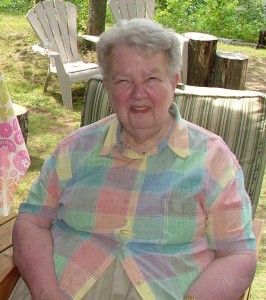
TORONTO, ONTARIO, FEB 13 2015 — Elizabeth Hancocks, for nearly a quarter of a century Dominion Genealogist of the United Empire Loyalist Association of Canada, died at Grace Hospital in Scarborough on February 13, 2015, after a short illness. She was 87.
It’s well conceivable to say that her work has indirectly influenced many of the applicants on this website, including her son, who is the webmaster and designer of the site. Indeed, her own ancestor, William Johnson, is listed here as an 1812 Veteran.
Continue reading Obituary of Elizabeth Hancocks, U.E., A.O.C.A., C.G., C.G.R.S., C.A.L.S.
Moses Merritt
4th Regiment Lincoln Militia
Commanding Officers: Captain William Nelles; Captain Jonathan Pettit
Daniel Young
5th Regiment Lincoln Militia
Captain Daniel Young, 5th Lincoln Militia Regiment
By William (Bill) Young, UE (January 20 2015)
Captain Daniel Young was my 4th great-grandfather.

